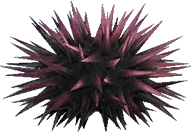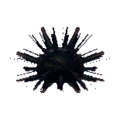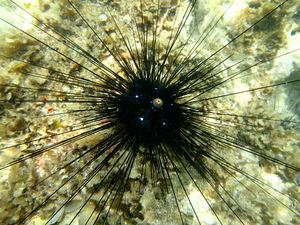Difference between revisions of "Sea urchin"
AlexBot2004 (talk | contribs) m (AlexBot2004 moved page Sea Urchin to Sea urchin over redirect: Using in-game capitalization per updated item capitalization policy) |
XX Ultimate (talk | contribs) m (specifying seasonality) |
||
| (5 intermediate revisions by 5 users not shown) | |||
| Line 1: | Line 1: | ||
{{Sea Creature Header}} | {{Sea Creature Header}} | ||
{{Infobox Sea Creature | {{Infobox Sea Creature | ||
| − | |name = | + | |name = sea urchin |
|ja-name = ウニ | |ja-name = ウニ | ||
|ko-name = 성게 | |ko-name = 성게 | ||
| Line 22: | Line 22: | ||
|price= 800 [[Bell]]s | |price= 800 [[Bell]]s | ||
}} | }} | ||
| − | The ''' | + | The '''sea urchin''' (ウニ, ''Uni'') is a type of [[sea creature]] in the {{SER}}, introduced in {{NL}}. |
| − | While initially absent from {{NH}}, the | + | While initially absent from {{NH}}, the sea urchin was added in the 1.3.0 [[Animal Crossing: New Horizons/Update history|Free Summer Update]] in July 2020, where it appears all day long as a small, slow shadow from late [[spring]] to early [[fall]]. |
In August 2020, it became available as a limited-time item in {{PC}}, where it is categorized as a [[shell]] rather than a sea creature. | In August 2020, it became available as a limited-time item in {{PC}}, where it is categorized as a [[shell]] rather than a sea creature. | ||
| Line 33: | Line 33: | ||
===In {{NL|short|nolink}}=== | ===In {{NL|short|nolink}}=== | ||
{{NLSeaCreatureInfo | {{NLSeaCreatureInfo | ||
| − | |name = | + | |name = sea urchin |
|number = 3 | |number = 3 | ||
|image = Sea Urchin NL Icon.png | |image = Sea Urchin NL Icon.png | ||
| Line 57: | Line 57: | ||
===In {{NH|short|nolink}}=== | ===In {{NH|short|nolink}}=== | ||
| − | In {{NH|short|nolink}}, a | + | In {{NH|short|nolink}}, a sea urchin is used as an ingredient in the fish meunière dish on [[Turkey Day]] in the southern hemisphere. |
{{NHSeaCreatureInfo | {{NHSeaCreatureInfo | ||
| + | | name = sea urchin | ||
| number = 6 | | number = 6 | ||
| image = Sea Urchin NH Icon.png | | image = Sea Urchin NH Icon.png | ||
| + | | render = Sea Urchin NH.png | ||
| catchphrase = I got a sea urchin! Wasn't even 'earchin for it. | | catchphrase = I got a sea urchin! Wasn't even 'earchin for it. | ||
| n-availability = May – Sep | | n-availability = May – Sep | ||
| Line 86: | Line 88: | ||
===In {{PC|short|nolink}}=== | ===In {{PC|short|nolink}}=== | ||
[[File:Sea Urchin PC Icon.png|thumb|left|Icon for the Sea Urchin in {{PC|short|nolink}}]] | [[File:Sea Urchin PC Icon.png|thumb|left|Icon for the Sea Urchin in {{PC|short|nolink}}]] | ||
| − | The | + | The sea urchin appears as a shell in {{PC}} and was available to collect for a limited time as part of the Sandy Shellfish Goals event, from August 20 to August 23, 2020. During the event, the shell would appear on the beach at [[Saltwater Shores]], where it could be picked up. After the event, remaining Sea Urchins can stay in the player's inventory, where they can still be sold, used for animal requests, or listed in the player's Market Box. The sell price for this shell is {{Currency|Bells|500}}. For villager requests, it is part of rarity tier 1, which earns the player {{Currency|Bells|100}} and 2 [[File:Heart PC Icon.png|15px|link=]] Friendship Points if the shell is used to fulfill a request. |
{{Clear|left}} | {{Clear|left}} | ||
==Donating to the museum== | ==Donating to the museum== | ||
===In {{NL|short|nolink}}=== | ===In {{NL|short|nolink}}=== | ||
| − | Upon donating a | + | Upon donating a sea urchin to the [[museum]], it can be found in the large pool in the first room of the Sea exhibit, along with many other species of sea creature. It is found in the part of the pool closer to the entrance to the saltwater exhibit. The exhibit has this to say about the sea urchin: |
{{Blathers|NL|Sea urchins are a close relative of both [[Sea Star|starfish]] and sea cucumbers and are assumed to be stationary. In actuality, they are capable of walking thanks to their many skinny legs they have between their spikes. They feed on [[seaweed]] on the ocean floor using their strong mouths located on their undersides. They are rich in nutrients but also have a lot of cholesterol, so take care not to eat too much.}} | {{Blathers|NL|Sea urchins are a close relative of both [[Sea Star|starfish]] and sea cucumbers and are assumed to be stationary. In actuality, they are capable of walking thanks to their many skinny legs they have between their spikes. They feed on [[seaweed]] on the ocean floor using their strong mouths located on their undersides. They are rich in nutrients but also have a lot of cholesterol, so take care not to eat too much.}} | ||
| Line 98: | Line 100: | ||
{{Blathers|NH|Ah, the '''sea urchin'''...the unabashed goth of the ocean floor! Indeed, with its mane of dark-hued spikes, it looks for all the world as if it might front a punk-rock band. Perhaps its more demure relatives—the '''sea cucumber''' and the '''sea star'''—disapprove of its outlandish look? 'Twould certainly explain why '''sea stars''' gobble up '''sea urchins''' every chance they get! But worry not for our spiky friend. Its venomous spines are an effective deterrent to many a predator. And then there are its sticky "tube feet," which it uses to maneuver out of harm's way. TUBE feet, I say! What will this salty rebel think of next?}} | {{Blathers|NH|Ah, the '''sea urchin'''...the unabashed goth of the ocean floor! Indeed, with its mane of dark-hued spikes, it looks for all the world as if it might front a punk-rock band. Perhaps its more demure relatives—the '''sea cucumber''' and the '''sea star'''—disapprove of its outlandish look? 'Twould certainly explain why '''sea stars''' gobble up '''sea urchins''' every chance they get! But worry not for our spiky friend. Its venomous spines are an effective deterrent to many a predator. And then there are its sticky "tube feet," which it uses to maneuver out of harm's way. TUBE feet, I say! What will this salty rebel think of next?}} | ||
| − | The | + | The sea urchin can then be found in the icy tank in the back, alongside the [[sea butterfly]]. |
==Fishing Tourney== | ==Fishing Tourney== | ||
===In {{NL|short|nolink}}=== | ===In {{NL|short|nolink}}=== | ||
| − | During a [[Fishing Tourney]], when given a | + | During a [[Fishing Tourney]], when given a sea urchin, [[Chip]] will not score the sea creature but will say the following: |
{{Chip|NL|When it comes to sea urchins, you can use 'em for sashimi or sushi, but whatever you do, keep 'em raw! Me, I like them fresh out of the water! Just watch for the spines, and you're good as gravy! YUM!}} | {{Chip|NL|When it comes to sea urchins, you can use 'em for sashimi or sushi, but whatever you do, keep 'em raw! Me, I like them fresh out of the water! Just watch for the spines, and you're good as gravy! YUM!}} | ||
| Line 109: | Line 111: | ||
==Real-world information== | ==Real-world information== | ||
| − | [[File:Sea Urchin Real.jpg|thumb|left|A real life sea urchin]] | + | [[File:Sea Urchin Real.jpg|thumb|left|A real-life sea urchin]] |
Urchins typically range in size from 3 to 10 cm (1 to 4 in), although the largest species can reach up to 36 cm (14 in). They have a rigid, usually spherical body bearing moveable spines, which gives the class the name Echinoidea (from the Greek ''ekhinos'', spine). The name "urchin" is an old word for hedgehog, which sea urchins resemble; they have archaically been called sea hedgehogs. The name is derived from Old French ''herichun'', from Latin ''ericius'', hedgehog. | Urchins typically range in size from 3 to 10 cm (1 to 4 in), although the largest species can reach up to 36 cm (14 in). They have a rigid, usually spherical body bearing moveable spines, which gives the class the name Echinoidea (from the Greek ''ekhinos'', spine). The name "urchin" is an old word for hedgehog, which sea urchins resemble; they have archaically been called sea hedgehogs. The name is derived from Old French ''herichun'', from Latin ''ericius'', hedgehog. | ||
| Line 143: | Line 145: | ||
}} | }} | ||
| − | {{Sea | + | {{Navbox Sea Creatures}} |
[[Category:Sea creatures]] | [[Category:Sea creatures]] | ||
[[Category:New Leaf sea creatures]] | [[Category:New Leaf sea creatures]] | ||
[[Category:Happy Home Designer sea creatures]] | [[Category:Happy Home Designer sea creatures]] | ||
[[Category:New Horizons sea creatures]] | [[Category:New Horizons sea creatures]] | ||
| + | |||
| + | [[es:Erizo de mar]] | ||
Latest revision as of 15:41, January 20, 2024
The sea urchin (ウニ, Uni) is a type of sea creature in the Animal Crossing series, introduced in Animal Crossing: New Leaf.
While initially absent from Animal Crossing: New Horizons, the sea urchin was added in the 1.3.0 Free Summer Update in July 2020, where it appears all day long as a small, slow shadow from late spring to early fall.
In August 2020, it became available as a limited-time item in Animal Crossing: Pocket Camp, where it is categorized as a shell rather than a sea creature.
Catch details[edit]
In New Leaf[edit]
| Time of year | May – Sep 15 All year (Tortimer Island) |
|---|---|
| Time of day | All day |
| Peak times | Jun – Aug |
| Shadow size | Small |
| Shadow movement | Stationary |
| Sea creature size | 12 cm |
| Rarity | Common |
| Selling price | |
| Furniture size |
In New Horizons[edit]
In New Horizons, a sea urchin is used as an ingredient in the fish meunière dish on Turkey Day in the southern hemisphere.
| Time of year | North: May – Sep South: Nov – Mar |
|---|---|
| Time of day | All day |
| Shadow size | Small |
| Shadow movement | Slow |
| Spawn requirement | Appears from the start of the game |
| Selling price | |
| Furniture size |
In Pocket Camp[edit]
The sea urchin appears as a shell in Animal Crossing: Pocket Camp and was available to collect for a limited time as part of the Sandy Shellfish Goals event, from August 20 to August 23, 2020. During the event, the shell would appear on the beach at Saltwater Shores, where it could be picked up. After the event, remaining Sea Urchins can stay in the player's inventory, where they can still be sold, used for animal requests, or listed in the player's Market Box. The sell price for this shell is ![]() 500 Bells. For villager requests, it is part of rarity tier 1, which earns the player
500 Bells. For villager requests, it is part of rarity tier 1, which earns the player ![]() 100 Bells and 2
100 Bells and 2 ![]() Friendship Points if the shell is used to fulfill a request.
Friendship Points if the shell is used to fulfill a request.
Donating to the museum[edit]
In New Leaf[edit]
Upon donating a sea urchin to the museum, it can be found in the large pool in the first room of the Sea exhibit, along with many other species of sea creature. It is found in the part of the pool closer to the entrance to the saltwater exhibit. The exhibit has this to say about the sea urchin:
In New Horizons[edit]
When donating to the museum, Blathers will say the following:
The sea urchin can then be found in the icy tank in the back, alongside the sea butterfly.
Fishing Tourney[edit]
In New Leaf[edit]
During a Fishing Tourney, when given a sea urchin, Chip will not score the sea creature but will say the following:
Gallery[edit]
Real-world information[edit]
Urchins typically range in size from 3 to 10 cm (1 to 4 in), although the largest species can reach up to 36 cm (14 in). They have a rigid, usually spherical body bearing moveable spines, which gives the class the name Echinoidea (from the Greek ekhinos, spine). The name "urchin" is an old word for hedgehog, which sea urchins resemble; they have archaically been called sea hedgehogs. The name is derived from Old French herichun, from Latin ericius, hedgehog.
Like other echinoderms, sea urchin early larvae have bilateral symmetry, but they develop five-fold symmetry as they mature. This is most apparent in the "regular" sea urchins, which have roughly spherical bodies with five equally sized parts radiating out from their central axes. The mouth is at the base of the animal; the lower surface is described as "oral" and the upper surface as "aboral".
More information on this topic is available at Wikipedia.
Names in other languages[edit]
| ウニ uni |
Sea urchin | |
| 성게 seong-ge |
Sea urchin | |
| 海胆 hǎidǎn |
Sea urchin | |
| 海膽 Unknown |
||
| Морской еж Morskoy yezh |
Sea urchin, lit. "sea hedgehog" | |
| Zee-egel | Sea urchin, lit. "sea hedgehog" | |
| Seeigel | Sea urchin, lit. "sea hedgehog" | |
| Erizo de mar | Sea urchin, lit. "sea hedgehog" | |
| Oursin | Sea urchin. Likely derived from "ours" (bear) and "hérisson" (hedgehog). | |
| Riccio di mare | Sea urchin, lit. "sea hedgehog" | |
| Sea creatures | |||||||||||||||||||
|---|---|---|---|---|---|---|---|---|---|---|---|---|---|---|---|---|---|---|---|
| |||||||||||||||||||






